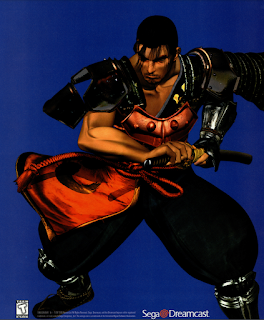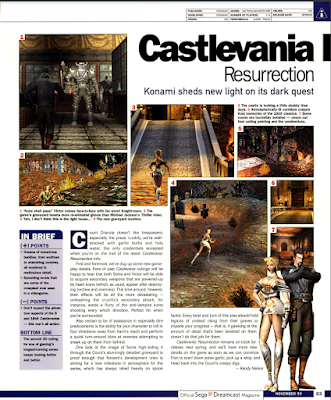Magazine Spotlight!
1999 was a pivotal turning point for the video game market. Sony's PlayStation had been out since '95, but the new PlayStation 2 was on the horizon, the N64 had hit it's stride the year prior and was having good releases this year like Donkey Kong 64, Super Smash Bros. and more. During all this Sega, once a majority stake holder in the game market with their Genesis, is just coming off the heels of a commercial failure with the Sega Saturn. A lot of bad decisions were made with the Saturn (too much to go over in this article) but a new hope is on the horizon for Sega fans, the Dreamcast. Released on 9/9/99 the Dreamcast is the most advanced video game home console released to this point, featuring a 128-bit processor, built in online and VGA graphics out for better resolutions. This brings us to the Official Dreamcast Magazine, which is still in it's infancy as the Dreamcast just came out. Today we are going to take a look at the articles, advertisements, reviews and interviews from the November 1999 issue of the Official Dreamcast Magazine.
When you first open up the magazine, you're greeted with an ad for Trick Style, a futuristic skateboarding game, and then a message from the editor in chief congratulating the reader for, purchasing the magazine, as well as a double congrats if you've already bought a Dreamcast at this stage. Editor Simon Cox informs the reader of Sega's success thus far saying "by the time you read this, there will be over 350,000 Dreamcasts in American homes." This number may be more accurate than what Sega had reported earlier in September saying they sold over 500,000 units (insert WSJ here). Either way, the Dreamcast was making waves in the US and a lot of great games were on the horizon as we will go over. Before some games are covered is a section with reader submitted letters/emails. One reader asks if Square's games or Metal Gear Solid will come to the Dreamcast, which gets shot down pretty quickly. Another reader asks some questions about the online functionality, some and when the microphone is coming out because they want to play Seaman. My favorite is a letter from a guy named Thomas who says, and I quote "what's that sucking sound? Oh yea it's the content of your new mag". Seems a lil harsh if you ask me. He then complains about House of the Dead 2 and why they gave it a 8 out of 10 saying that the game was repetitive and boring. I guess everyone has their different opinion.
After the fan mail is the section on the latest Dreamcast news and announcements. This section was where I had the most interest personally, because usually it's where you can compare and contrast to what actually happened vs. what didn't over the course of the Dreamcast's lifespan. For example you have more in depth previews and updates on Dreamcast staples like Shenmue and Seaman that are coming to the system from Sega
directly, but also 3rd party games that didn't quite make it to the Dreamcast but did for other systems like Tekken Tag Tournament, Max Payne, Half Life and more. They also give a shout to Bernie Stolar, previous Sega of America president stepping down and being superseded by Toshiro Kesuka. Bernie Stolar didn't have the easiest time being president of Sega during his time. He took over after the former Mattel executive, Tom Kalinske, had taken the Sega brand during the 16-bit era and aggressively positioned it against the competition, and in 1993 making the Genesis have the majority market share in the industry (insert ign reference here). However, after many missteps during the end of the Genesis and the beginning of the Saturn's era, Tom Kalinske had stepped down in 1996 leaving Stolar to pick up the pieces of a company that was bleeding money and with a product that was a 3rd place in the industry. After declaring that "the Saturn is not our future" in 1997, he pivoted into the new Dreamcast system, but wasn't there for the entirety of the system's lifespan. I think that it's interesting the president of your company leaving is only worth a footnote in the news section of your console's magazine. A president of a company was usually a key component of announcements and public image, especially since E3 had just had it's first show in 1995 and was becoming a more publicized event. Another minor point in this news I wanted to look at was that Majesco had announced that they were re-releasing the Game Gear at a budget price, which did happen. They also mention that they were planning a re-release of Sega Saturn systems and games which I don't believe they ever did. Majesco had rights in the late 90's to manufacture their own older Sega systems, including the aforementioned Game Gear reissue along with the Genesis Model 3. It would've been interesting to see if they did reissue the Saturn or games if they would shift the packaging to be different from the rest of the Saturn library, or if they would create a new design for the console to adhere with their budget.

There are also a handful of ads for 3rd party controllers, some of which look so uncomfortable and cheap in quality it's not even funny. I remember 3rd party controllers being a larger part of my childhood, especially the Rock Candy glowing controllers and Gamestop's crappy offerings, but never anything compared to what InterAct had on offer. Lastly, there were several ads and information about the Neo Geo Pocket Color.
The Neo Geo Pocket Color, released a few months prior to the Dreamcast in the US, had somewhat of a symbiotic relationship with the system. Sega actually developed a handful of games for the system, including Sonic's Pocket Adventure which also got a preview in this issue of DCM. They report that the game "should also move as fast as it's Genesis forebears - without the (unintentional) blur created by the slower refresh rates of older Game Gear and Nomad screens".
Now we come to probably the most important part of gaming publications, previews of games to come and reviews of games that are coming out. Starting with the previews, DCM looks at a handful of interesting and not so interesting games coming out in the coming months. MDX 2 is one of the first games they preview, a Bioware shooter/action game coming out in early 2000 for the console. DCM accentuates the fact you'll be able to play as 3 different characters in the sequel, with each specializing a different style of gameplay, whether stealth or more guns blazing. MDX 2 did come out for the Dreamcast in addition to PS2 and PC. As far as Sega offerings on preview, we have 2 games in Toy Commander and Extreme Boarders. Toy Commander was an action strategy game where you take control of toy vehicles like RC cars, helicopters and more to do various tasks around the house. By the time Toy Commander came out both Toy Story 1 and 2 had come out in the states, but I haven't actually played the game to see if any inspiration other than the main concept of toys coming to life had any effect on the game. On the other hand we have Extreme Boarders developed by the same company as Cool Boarders on PS1 and published by Sega. DCM highlights both the trick mode on the halfpipe as well as free mode where it's you against the elements trying to get down the mountain. The biggest thing that DCM is excited for is the improved visuals moving from a 32-bit to 128-bit system, and hopes that the announcer from the previous entries holds back on the cheese factor. Extreme Boarders did eventually come out on Dreamcast, but under the title of Rippin' Riders Snowboarding.
Ending off our look at some of the previews is Castlevania Resurrection, an unreleased Castlevania game for the system. The preview includes some screenshots and preliminary renders of the game, along with gameplay features both new and old, like grabbing hearts for secondary weapons, as well as a new dodge roll. While the game was slated for a spring of 2000 release, the game never saw the light of day. There is an unreleased prototype build of the game floating around online, so if you're really interested in what might've been you can check that out.
Last but not least we enter the Test Zone where all games that have released or are getting ready for release are reviewed and given a score. This issues biggest review is the 6 page review on 6 different fighting game offerings for the Dreamcast including Soulcalibur, Virtua Fighter 3TB, Power Stone, Street Fighter Alpha 3, Marvel vs. Capcom and Mortal Kombat Gold. For each game they rank them in 4 categories and assign a winner and runner-ups with the categories being best gameplay, graphics, replay value and characters. Soulcalibur ends up winning most of the categories, tying with Virtua Fighter 3TB in Gameplay and Street Fighter Alpha 3 winning best characters. Something to note about the graphics department was what the publication had to say on the 2D Capcom offerings, saying that comparing SF Alpha to Soulcalibur is "really like comparing apples to oranges" and calls SF Alpha "by far the best-looking 2D game available on the Dreamcast." This is at least shows more openness to 2D offerings, but that gaming in the years to come is still largely 3D skewed in terms of what graphics are favorable. Soulcalibur still wins overall with a 9/10 rating, and most other offerings getting a 8/10 or slightly lower apart from M.K Gold which got a 3/10.
Other games reviewed include NFL 2K, which got a 9/10 and a compliment from the reviewers saying "this is the best overall football game we've ever played". They praise the graphics, play-by-play commentary that never gets repetitive and the VMU play calling making a 2 player couch co-op game more strategic since plays are hidden from your opponent. The only real negative they give the game is the lack of running options for offense. That still doesn't stop the game from receiving the Dream Game Award for the issue. Further back in the reviews, DCM gives more rapid-fire opinions including reviews on some racing games that just hit the platform like Hydro Thunder, Tokyo Xtreme Racer and Flag to Flag. They also review other Sega 1st party offerings like Sega Bass Fishing and Dynamite Cop, but end up giving them middling scores due to lack of replayability.
Overall I think DCM was a well structured publication that gave interesting insight for games on Sega's last home console. There is plenty more to read in the issue, so if you're interested give it a shot! I'll include a PDF version I used for some pictures down below if you want to read the entire issue. DCM overall didn't have a terribly long print run, lasting about as long as the Dreamcast itself, but I enjoyed my time reading this issue and will definitely look into getting more! DCM will have been the 3rd publication I've given a spotlight to, but what would you like me to look more into? I still have plenty of issues of Nintendo Power, Japanese Sega Saturn Magazine as well as 20-30 issues or so of EGM from the early to mid 2010's I can take a look at as well. Thanks for reading this magazine spotlight and keep an eye out for more in the future!
References:
https://www.wsj.com/articles/SB938129466996877414
https://retrocdn.net/images/8/8f/ODCM_US_02.pdf
https://www.ign.com/articles/2009/03/20/genesis-vs-snes-by-the-numbers
https://twitter.com/CGQuarterly/status/1160678661726433280/photo/1
https://segaretro.org/Neo_Geo_Pocket/Dreamcast_Setsuzoku_Cable














